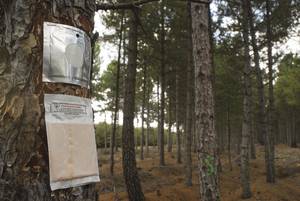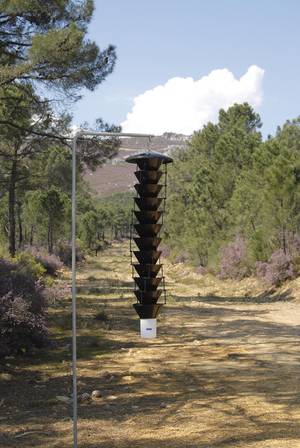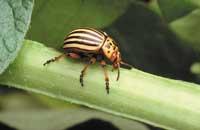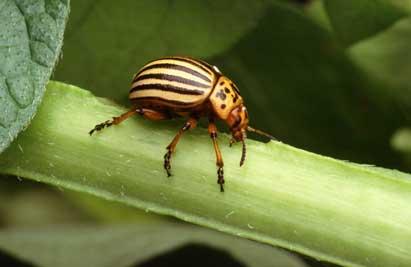Chemical messages and beetle management sexips dentatus
2014/02/01 Etxebeste Larrañaga, Iñaki - Ekologia departamentua, Suediako Nekazaritza Zientzien Unibertsitatea (Sveriges Lantbruksuniversitet, SLU), Uppsala, Suedia. Iturria: Elhuyar aldizkaria

It has been more than 50 years since the intermediation of infochemical substances in communication between animals was demonstrated. These are substances that can lead to a message and that have gained special importance in the sustainable management of some pests, since they have largely replaced the use of potentially harmful pesticides for the environment and have contributed to a better knowledge of the relationships between insects convertible into pests and their environment. The Ips sexdentatus beetle, like its other escorted relatives, can cause losses in pine farms if the conditions are adequate. Although some of the components of its pheromone have long been known, the chemical messages have not been used until recently, neither in the management of this piercing beetle nor in the investigation of its ecology.
Drilling beetles and sustainable pinewood management
The beetles of the Scolytinae subfamily have a great influence on temperate forests around the world. For example, more than 500 species can be found that feed on trees of the genus Pinus L. Most of them do not cause any damage, but few can feed on live trees, so they become competitors of the human being by the wood they both need. Although the impact of these species can generate a saproxylic habitat so important for forest diversity, the condition itself becomes a source of diversity of ages, sizes and densities of the planted forests, compromising the viability of the farms.
Among the scholars who can become epidemics is Ips sexdentatus Boerner. Although it can be located throughout the Eurasian continent, its influence on the forestry sector is mainly limited to southern Europe and Mediterranean countries. Among them are the ash ( Pinus sylvestris L.), the maritime pine ( P. pinaster Aiton), the laritium ( P. nigra Arnold) or the insignis pine ( P. radiada D. Don) can be found on the float. Like other beetles of the same genus, the I. sexdentatus attack piercing the skin of the pines. Once in the floema, it is proceeded to the size of the wedding chamber, where wet infochemical substances are released in the removed chips. The message released attracts the females who, once fertilized, carve the mother chambers that leave from the gallery of weddings. The females lay eggs on the sides of these chambers, from where the males fed with floema will come out. In short, new-generation beetles will leave the cameras built under the skin.
Under normal conditions, I. sexdentatus grows in fallen and sick trees that we can find in the pine forests, since the number of beetles that can be collected by isolated attacks is not enough to overcome the defenses of healthy pines. However, strong venteos, fires, poorly built basoles and other extraordinary events leave unprotected trunks. Beetles grow uncontrollably in a short time to attack healthy trees. Thus, in the millions of marine pines that the storm Klaus of 23 January 2009 launched in the forest of Landeta, the I. sexdentatus reproduces as never before, and by September 2010 3,9 million cubic meters were destroyed by the influence of the beetle, in addition to the wood exposed by the wind in a previously healthy pine forest. In addition to this parasitic posture, like other scholars, I. sexdentatus is capable of transporting phytopathogenic fungi. Among the investigations carried out in the Autonomous Community of the Basque Country are the indications of the fungus Fusarium circinatum Niremberg and O'Donnell on the beetle, in addition to the chromogenic fungi, which dye the blue wood and reduce the economic value of the wood. The management of schooling as potential vectors of highly harmful diseases has been reinforced by numerous forestry and forest managers. One of the clearest examples of the past is that some scholars of the genus Scolytus were responsible for the diffusion of the graphosis of the elms, causing the almost total disappearance of this tree species of our environment.
Chemical messengers who call to pick up
Shortly after demonstrating the very existence of Pheromone, at the beginning of the seventies, ipsdienol was discovered, the most important substance of the beetle collection pheromone I sexdentatus. Although the usefulness of pheromones has been recognized from the beginning, like other forest pests, the traps dressed with this pheromone have not been used until a few years ago, and in the case of beetle I sexdentatus there was no mixture of reference pheromone. Taking into account the specific substances that the insect derives in the process of colonization, one of our main objectives has been the study of mixtures that improve the results of these traps used by forest managers, as well as their influence on other saproxylic insects very related to the escorts.
After some trials it has been possible to improve the chemical hook that is sold, considerably improving the number of escorts that are sold for the trap. In addition, as we have seen in a second group of trials, the change in proportion of a substance in the improved mixture results in very different responses, both from the beetle I sexdentatus, and from the composition of the catches, competitors and, in general, from the saproxylic beetles that approach the same habitat using the same message.
Involuntary baskets of prey
Pheromones, or mixtures of substances that compose them, have a very specific influence on the pests to which they are directed, in comparison with most of the pesticides, but, when transporting a message, they are also used by other insects that act silently, as the predators of the escorts. Two of them, Thanasimus formicarius (Coleoptera: Cleridae) and Temnochila caerulea (Col.: Trogossitidae), are captured in very high amounts in capture programs performed to reduce the populations of sexdentatus I. Forest managers often assume the task of releasing potentially beneficial baskets, but in most cases, predators are dead or seriously injured to perform sampling tasks. The adaptation of a network of trap screening with multiple funnels that are used for the capture of schooling has allowed to improve the results of these traps, improvements that at present have taken into account the traps marketing companies.
Message that calls to collect the impact of Berbenona
Berbenona is one of the substances most investigated in the management of schooling. While over the past few decades it has played a variety of roles, the main hypothesis that is currently used is that trees, as they die and degrade, release verbenone. The different species of schooling, depending on their food needs, have different responses to verbenes. Thus, in the case of Ips sexdentatus, the results indicate that they have a direct influence on the message that calls for collection, since it considerably reduces the number of insects collected in traps. We have shown that this inhibition can be used in practice to protect stacked pines or trunks and have introduced a new tool to forest managers. However, it has not been possible to stop the attack of other secondary scholars. Specifically, it has been shown that the scholar Orthotomicus erosus competes with Ips sexdentatus on the substrate and has seen the importance of chemical messages between them. This beetle also has the ability to transport fungi, so the accumulated trunk does not protect the verbenon from the bluish process.

Unlike what happens in our case, research with verbenone has obtained bilateral results that have slowed down the practical use of this substance. However, through meta-analysis we have been able to verify that this substance has a great influence, especially among the scholastics with the capacity to generate pests. After investigating the results of a total of 529 experiments, the results were obtained to support the main hypothesis of work. That is, verbenon transmits the message of the aging substrate. On the other hand, in most of the conditions investigated, verbenon has a great influence on these beetles.
Integral management of Ips sexdentatus
The need to manage outbreaks of schooling leads us to investigate their chemical ecology and to generate tools that are improving over time. But they are not the only tools available. The cleaning of the forests, the early collection of the fallen or sick pines, and the realization of work on time have known effects for a long time to avoid pests of schooling. In addition, it is common to treat stacked logs with pesticides. Taking into account its possible impact on the environment, chemical messages and traps can constitute a green alternative in the integral management of sexdentatus I.
References References References References
Thank you Thank you!
The research presented has been funded through the projects AGL 2004-07507-C04-04 and AGL 2007-61152 promoted by the Ministry of Education and Research. I would like to thank deeply my director of UVA, Juan A. Pajares and my colleague Estela Sánchez, Gonzalo Álvarez, Gema Pérez and Ana Martín, as well as many other colleagues from the university.

Gai honi buruzko eduki gehiago
Elhuyarrek garatutako teknologia







